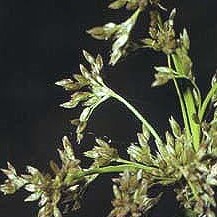Herbs, perennial, 5--15 dm. Rhizomes long, thick, scaly. Culms gray-green, 2--5 mm diam. Cataphylls 2--5. Leaves basal, 1--3; auricles absent; blade terete, 40--80 cdm x 1.5--2.5 mm. Inflorescences sympodial or appearing lateral, glomerules to 150, each with 2--6 perfect or pistillate flowers, congested to open, 4--20 x 5--10 cm; primary bracts terete, longer than inflorescence. Flowers: tepals pale brown, 2.5--3.3 mm, apex acuminate; outer series acuminate; inner series slightly shorter, acutish; stamens 6, sometimes rudimentary, filaments 0.2--0.7 mm, anthers 1.3--2.5 mm; style 0.3--1 mm. Capsules brown, 3-locular, ovoid to oblate, 1.7--3 x 1.3--1.6 mm, mostly distinctly shorter than perianth, apiculate. Seeds dark brown, ellipsoid, 0.4--0.6 mm, not tailed.


